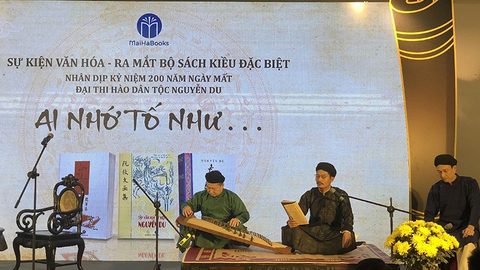The series of cultural events themed “Who remembers To Nhu”, held in the last three days of October at the Vietnam Women’s Museum in Hanoi on the occasion of the 200th death anniversary of great poet and cultural celebrity Nguyen Du (1980-2020), not only honoured but also affirmed the value and enduring vitality of “Truyen Kieu” (Tale of Kieu” in the contemporary life.

The performance of reciting Kieu at the programme.
At an exhibition on letters and paintings on Nguyen Du and the “Tale of Kieu”, the organisation MaiHaBooks introduced over 200 publications including various versions of the “Tale of Kieu” and research works on the masterpiece over several periods (from 1914 until now) and great poet Nguyen Du as well as more than 400 paintings on the literary work.
The exhibits displayed were across different themes: “Kieu in the era of Nguyen Du”; the publications of the “Tale of Kieu” during the 1900-1945 period; “Tale of Kieu” publications during the 1946-1954 period; the “Tale of Kieu” publications during the 1954-1975 and in contemporary life.
The study rooms of Confucian scholars in the 18th and 19th centuries as well as the interference between the western and eastern cultures in the early 20th century were reproduced. In particular the process involved in the study of Nguyen Du and the “Tale of Kieu” during the historical struggles for national independence was also introduced, helping viewers feel the soul and humanistic thought of poet Nguyen Du as well as the sentiments of the Vietnamese people and international friends to his masterpieces.
The large amount of literary works and paintings on The “Tale of Kieu” and Nguyen Du such as “Anecdotes and documents about Nguyen Du and the Tale of Kieu”, dictionary for the “Tale of Kieu” and the “Tale of Kieu” in Nom script, prove that the “Tale of Kieu” is no longer a poetic work but has become a cultural heritage of Vietnam.
With such a strong influence and spread, the “Tale of Kieu” has existed and developed persistently, inspiring the work’s lovers to create forms of cultural activities such as reciting Kieu, quoting from Kieu, telling fortunes from Kieu and composing new poems and paintings based on lines from the masterpiece.
During the series of culutral events, diverse activities attracted a large number of visitors who have always loved great poet Nguyen Du and the “Tale of Kieu”. The introduction of calligraphy and paintings related to Nguyen Du’s poems and the “Tale of Kieu” and reciting Kieu with the sound of dan tranh (Vietnamese 16-chord zither) were notable events.
The highlight of the event was the debut of three publications titled “Kim Van Kieu”, “Lam Thuy Tap” and a book remembering Nguyen Du from the organising board MaiHaBooks. In particular, Lam Thuy Tap is a collection of quotes and puzzles from Kieu and practices of Kieu that have been familiar across cultural activity in Vietnam and different poetic forms and styles. “Kim Van Kieu” is a publication reprinted by the edition of the Literature Publishing House in 1951. In the world of collectors and lovers of the “Tale of Kieu”, this is a beautiful, rare and valuable publication, honouring the values and significance of the masterpiece. It is also one of the special editions about the “Tale of Kieu” thanks to the six sub-versions of paintings on Kieu that were created by Indochinese artists.
The collection commemorating Nguyen Du was reprinted according to the 1942 edition by Prof. Dao Duy Anh. It resonated in the literary and fine arts world at the time because it not only honoured a great poem and poet of the nation and affirmed the important value of the “Tale of Kieu” in the history of language and culture but also honoured the illustrative arts and book printing industry of Vietnam. It featured beautiful recitals on the “Tale of Kieu” and 11 paintings by well-known artists including To Ngoc Van, Nguyen Gia Tri, Le Pho, Le Van De, Nguyen Tuong Lan and Tran Van Can.
For the “Tale of Kieu”, each person will have a specific feeling. It can be said that since it was a Nom script and it then changed into the national language as well as many other translations, the masterpiece has always created a strong sense of inspiration and fresh emotions for readers and researchers.
In addition to the aspiration to renew old features and promote the national quintessence to the public, the three publications were printed meticulously with many interesting points. They were the first publications in the bookcase "Vietnamese Heritage" from MaiHaBooks, expressing great respect to the legendary poet Nguyen Du and his masterpieces.
Source: NDO
VNQD